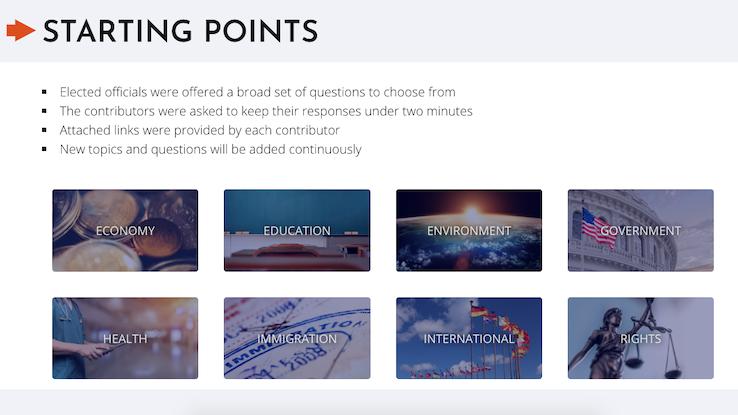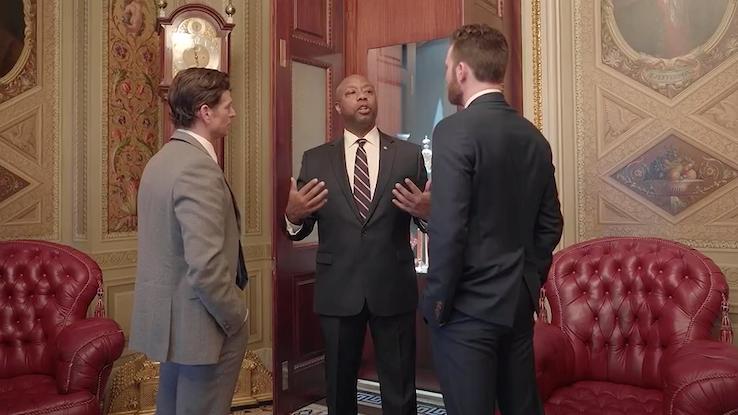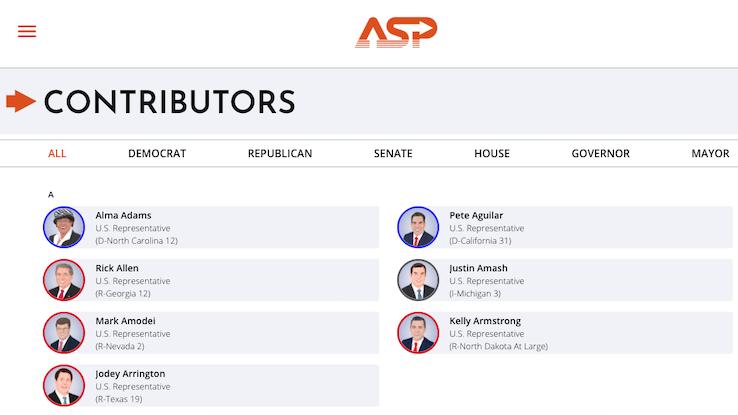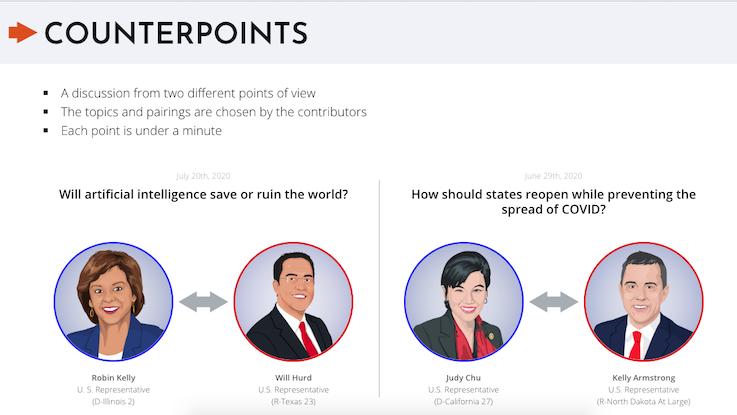Will the Character of Captain America Continue Without Chris Evens

Actor Chris Evans has been fighting for democracy onscreen for years in his role as Marvel superhero Captain America. Now he's taking the fight to real Americans with the launch of his new online platform, A Starting Point.
Evans developed the website along with businessman Mark Kassen and tech entrepreneur Joe Kiani to address a growing problem with political discourse: that communication between Americans about political issues is approaching a level of strain that can seem insurmountable — to the point that many are giving up trying. The site's founders feel the situation is unacceptable, as free, clear and accurate speech is a key component of a healthy democracy. A Starting Point is designed to become a solution that enriches communication between individual Americans and between citizens and their elected officials. But will people take Captain America's political site seriously?
Getting Started With A Starting Point
The site, in the words of its founders, is "a video-based civic engagement platform" on a mission to "create a bipartisan channel of communication and connectivity between Americans and their elected officials with the goal of creating a more informed electorate." Its method for achieving that goal? Allowing political leaders from all over the country to film and upload quick videos of themselves discussing pertinent topics and engaging in civil debates with one another. The site's intention here is to provide politicians the opportunity to create raw, unfiltered and honest (a little more on that later) content without taking a side or highlighting one point of view over another.

One way it aims to achieve this is by keeping things simple, allowing the focus to remain on the content from politicians. There's no analysis, no breakdowns of their videos, which lets viewers consume and analyze information on their own and keeps the site itself impartial while also ensuring that the videos remain the true center of attention. A Starting Point looks deceptively basic, which again is meant to keep the video content at the forefront. There aren't big paragraphs of exposition to slog through, just quick bullet points explaining the goals of each section so viewers know what they can expect to gain from watching content on the different pages. In addition, the videos themselves are short and to the point — they're snackable so viewers can grasp the main takeaways of an issue, argument or opinion with ease.
The site is organized into a few key sections for easy navigation. From both the homepage and the site's menu, visitors can access a welcome video along with A Starting Point's primary content subsections. These include "Starting Points," which are two-minute-long videos about a range of current topics like healthcare, economics and education along with answers to questions related to those topics; "Daily Points," which is a freestyle forum where contributing politicians can post one-minute-long videos about their perspectives on different issues; and "Counterpoints," which positions two politicians with opposing viewpoints in a debate-style discussion utilizing video responses. Each of these sections includes a brief rundown of its purpose and of the issues addressed in the videos. And there's no production here; the politicians decide what they want to talk about and film the videos themselves.
Finally, in pursuit of that goal of creating an informed electorate, A Starting Point visitors can enter their ZIP codes to find out who their elected officials are and whether those leaders are using the site. They can also register to vote in upcoming elections using A Starting Point's link to TurboVote.
One of the biggest goals the website is looking to achieve revolves around helping users understand all sides of a given issue. Due, in part, to the influence of algorithm-driven social media, many people primarily have access to news sources and facts that reflect their own opinions, and they often only see posts on social media that reinforce their existing opinions instead of presenting cohesive arguments from the other side. The more readers link, share or comment on articles they like, the more often similar types of websites and news articles display on their social feeds, creating an endless loop that further fortifies one point of view.

This phenomenon can be more damaging than people realize. It quickly feeds into groupthink and perspective bubbles where individuals retain access to only those facts and examples that support what they already agree with. As individuals continue to hear only one side of a discussion, they may become so convinced of their own point of view that they avoid or dismiss any cognitive dissonance — the discomfort they have when presented with information that doesn't fit with their existing opinions about a subject. When they aren't given the option to confront their own beliefs, engage in critical thinking and access information that may cause them to question their beliefs, they don't have the opportunity to learn, grow or change — potentially for the better.
A Starting Point is built to address and dismantle this. It presents a range of sides on any given issue and commits itself to remaining non-partisan — giving both of the major political parties, along with others like Independents, equal access to a platform where they can explain their ideas and highlight issues that are their top priorities. Also, unlike social media sites (looking at you, Facebook), A Starting Point employs fact-checkers to review the politicians' content in an effort to cultivate a more accurate collection of media. The result is a knowledge base for critical thinking that may lead to improved decision-making on viewers' parts once they've reviewed accurate information about (and from) a range of perspectives.
Learning From That Range of Perspectives
With any kind of high-profile website that tackles issues of national importance, it would be easy to focus only on the most prominent politicians. That's not what this platform does. Instead, it includes officials who are in the best positions to offer valid takes on given issues that are relevant both to their constituents and the American public as a whole. Top-ranking officials are certainly present, but others are, too.

A Starting Point's vast list of contributors includes prominent senators from around the country, but it also provides a platform for state governors and even city mayors. This diversity allows the site to showcase a variety of opinions, of course, but it also provides constituents easy access to their local leaders' viewpoints in an easily digestible format — with information coming directly from the politicians themselves. This kind of straight-from-the-source communication is all too uncommon in this era of spokespeople and biased news outlets, and it can help viewers not only learn about but also form better connections to what's going on in their communities and what the people in charge are doing about it.
This in particular is where A Starting Point's Daily Points come into play. This area of the site is open to all the contributors who have signed up, and it's designed as an open forum where the politicians can upload videos about any topic they want to address. As mentioned, the videos here can be no more than a minute in length, which forces the participants to condense what they want to address down into the most salient points.
The result is that it facilitates viewers' understanding of bigger-picture ideas thanks to the quick-bite format. It's also easy for them to watch a wider range of videos — and expose themselves to a wider range of perspectives in the process — because watching five or even ten Daily Points doesn't require a large time commitment. It also won't overwhelm viewers with a flurry of confusing details. The videos appear in a chronological feed, and they're organized with tags for easy access; this social media-esque formatting is familiar, something viewers will be comfortable with. And that ultimately improves the site's usability while providing access to many perspectives.
Here's Where the Site Really Shines
The platform's structure addresses some of the communication faux pas that are seen regularly in other formats like large town halls, morning talk shows and cable TV news networks. Think back to the last time you watched a town hall-format discussion on a news network. Did it quickly escalate into participants yelling over each other? Or was it an echo chamber that lacked stimulation or intrigue because everyone shared the same point of view? These and other poor communication behaviors, which can turn off the public and become barriers to civic engagement, aren't elements of A Starting Point.

Why is that? The Counterpoints section, for one thing. This area of the site allows two politicians with differing opinions to create pre-recorded video clips responding to each other in a discussion of a given topic. The discussion format allows participants to get their points across clearly in their filmed clips, and it also prevents them from interrupting their peers. Listeners can hear each participant's entire perspective — free of interruptions that cause the discussion to devolve into a shouting or name-calling match.
In addition, the time lengths on the videos prevent officials from talking on at length, which helps in impartially controlling a conversation. A discussion moderator on live TV could allow someone who shared their same opinion to speak at length and then turn around and cut off another participant who has an opposing point of view. The sort of inbuilt moderation that's native to A Starting Point's platform prevents this type of censorship and gives everyone equal opportunities to share and respond. Participants in Counterpoints also are each allowed to record a closing statement reiterating what they feel are their most important points or arguments, sort of like the wrap-up to a debate, to reinforce their ideas.
Another benefit of the platform's structure is that it allows users to hear responses and views in an unedited form. They can clearly see and hear what each official is saying, not hear spin or get information through the filter of another commentator or potentially biased reporting source. Because the video clips are pre-recorded, the politicians also have a chance to clearly articulate their points. They don't have to worry about being interrupted and can plan out in advance what they want to say and how they'll say it. Once viewers watch a set of Counterpoints videos, they can decide what they think for themselves.
Are Americans Ready for A Starting Point?
It's one thing to have a platform that's committed to showing both sides of what are often controversial issues. It's another thing for the public to then engage in civil, constructive discourse. Can people stay civil in response to the videos and use them to become more educated, or will the site just contribute to media noise? Only time will tell.

In an interview with media watchdog Columbia Journalism Review, Margaret Sullivan, a media critic for The Washington Post, warns of problems with the site. She notes that it's set up to give equal weight to two sides of an argument, even if one of the sides lacks credibility — like, say, one participant stating hydroxychloroquine can cure COVID-19. Giving this type of discourse a platform could ultimately be dangerous. Sullivan questions whether the platform would highlight both sides of issues like voter suppression and climate change, which, when looking at actual research and facts, don't really have room for opinions about whether the issues are occurring or not. (For the record? They're real, they're happening right now and we need to do something about them before it's too late.) It's also worth asking whether A Starting Point would give a platform to those who see white supremacists as "good people" or believe in vaccine hoaxes.
In addition to this, many issues have more than two points of view. There can be three, four or even more ways to view a topic, and there can be variations and caveats under the umbrella of just one of these opinions. Showing all perspectives is an important and admirable part of helping users to thoroughly understand an issue, but it may prove difficult on a site that appears set up to create an opinion binary.
While the site's ultimate impact will only come to light over time, it's clear that what A Starting Point can do right now is serve as an actual starting point for people who have questions about journalism, for those who want to gain a better understanding of the United States' political climate and for viewers who want a simple introduction to current-events topics ranging from immigration to healthcare to the environment.
For now, we're left with some questions. What does it mean to be informed? When is presenting all sides of an issue a valid choice? How do Americans respond to information they don't agree with? What is the role of an editor in selecting and presenting information to the public? At least one thing is certain: Watching how A Starting Point's creators address these issues will be fascinating.
Source: https://www.ask.com/culture/chris-evans-new-website-starting-point?utm_content=params%3Ao%3D740004%26ad%3DdirN%26qo%3DserpIndex&ueid=3445ee69-003d-4a1f-8753-f60f4b1faa21
0 Response to "Will the Character of Captain America Continue Without Chris Evens"
Postar um comentário